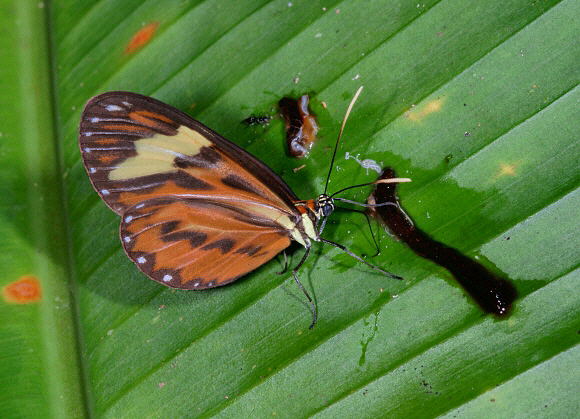
Introduction
The Ithomiini comprises of 376 known species, although it is likely that at least another 30 will be discovered in the near future. All are confined to the neotropical region. Ithomiines are unpalatable to birds, and are consequently mimicked in appearance by many other species. These include other unpalatable species ( M�llerian mimics ), not only from the Ithomiini but also from several other butterfly families. There are also a large number of edible species ( Batesian mimics ) which have evolved similar patterns. Birds have the ability to memorise butterfly patterns and so learn to avoid eating noxious species, but are also fooled into ignoring similarly marked edible species.
Ithomiines are characterised by having small eyes, slender abdomens and long drooping antennae that lack distinct clubs. Males have a plume of long androconial scales or “hair pencils” on the costa of their hindwings. These are hidden from view when the butterflies are at rest, but are displayed when the wings are held open during courtship. Other Ithomiine characteristics include a very slow and deep wing beat, and a preference for inhabiting the darkest recesses of the forest understorey.
There are basically 2 types of Ithomiine. The first type are the black and orange-banded “tigers”, many of which are mimicked by other species due to their unpalatability to birds. The second type are the “glasswings”, recognised by their transparent or translucent wings, prominent veins, and orange wing margins. Many genera contain examples of both of these types, and in some cases an individual species may produce adults of both forms according to location.
Most novices find the Ithomiini very difficult to identify. Using only the patterns to identify species is very unreliable because there are so many similar species. Also many species produce a variety of different colour forms according to locality and season. The best approach therefore is to use the hindwing venation and other anatomical features to identify the genus, and to then look at the wing patterns to short-list the likely species.
The genus Napeogenes contains 22 known species of small to medium sized Ithomiines, some falling into the “Glasswing” category while others have the black, orange and yellow makings typical of the “Tiger” mimicry complex. There are 6 genera – Aremfoxia, Epityches, Hyaliris, Napeogenes, Rhodussa and Hypothyris.
There is some contention between taxonomists as to whether this species should be classified under the genus Hypothyris or Rhodussa. It has also at various stages of history been classified under Ceratinia and Ithomia. Lamas ( 2004 ) includes this and 17 other species in Hypothyris, and regards Rhodussa as a junior synonym. Brabant however points out ( pers comm ) that there are minor differences in the venation of Hypothyris and Rhodussa, and places cantobrica in the latter genus.
This species is found in the upper Amazon regions of Brazil, Peru and Bolivia.
Habitats
The butterfly occurs in lowland rainforest at altitudes between about 100-900 metres.
Lifecycle
To be completed.
Adult behaviour
The butterflies are usually observed as singletons, seen at rest on foliage in light gaps where trees have fallen in the forest. This probably implies that they spend much of their time in the middle or upper canopy, only descending at places where the sunlight penetrates to lower levels.
Like other Ithomiines, the butterflies spend long periods at rest on the foliage of small shrubs in the darkness of their rainforest and cloudforest habitats. They are extremely nervous, and if disturbed fly immediately, only to resettle on another nearby leaf. The flight is very slow, with characteristic deep wing beats. When feeding in the open they behave very differently – both sexes being very placid and reluctant to leave their flowers.
Males sequester pyrrolizidine alkaloids from Heliotropium, Tournefourtia, Myosotis ( Boraginaceae ), Eupatorium, Neomiranda and Senecio ( Asteraceae ). These chemicals confer toxic qualities to the butterflies which deter bird attacks. The chemicals are also used in the production of pheromones. Often the males of several Ithomiine species will gather together at communal leks, where they release these pheromones from hair-like androconial scales on the leading edge of their upperside hindwings. These attract more males, which in turn release further pheromones.
After a few days the lek may include 50 or more adults comprised of as many as dozen different species. Passing females are attracted to the leks by the complex fragrances. Their presence stimulates the males to open their wings and release further pheromones that entice them into copulation. Females obtain sustenance from nectar, and also visit bird droppings which provide them with a source of nitrogen that assists with the development of their eggs.
